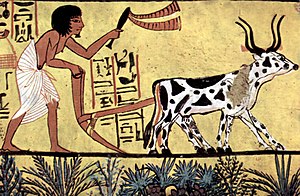History of agriculture

Agriculture is the activity of growing crops and raising animals for food, clothing and other products. It contributed to the growth of civilizations.[1]
Prehistoric Agriculture[change | change source]
Agriculture began around 12,000 years ago. People collected wild plant seeds and planted them. They also domesticated wild animals. The cultivation and domestication of plants and animals was originated.
Ancient[change | change source]
Ancient civilizations such as Mesopotamia, Egypt, China and India improved agriculture. They developed irrigation systems to provide water to the crops. They cultivated fields with animals. Wheat, barley, rice and grain were among the major crops.[2]
Medieval[change | change source]
During the Middle ages in Europe, farming technology improved. Farmers can plant crops on deep clay soil with heavy blades. Harvest rates increased with a three-field rotation of crops method. Horses took the role of cattle in farming. Farmers planted wheat, barley, peas, and beans.
Modern[change | change source]
The Agricultural Revolution began during the 1700s and 1800s. New farming technology, such as the seed drill, improved crop planting. Selective breeding increased productivity in both animals and crops. In the 1900s, agriculture became more productive. Tractors and additional machinery replaced animal power. Better fertilizers and pesticides were developed.
References[change | change source]
- ↑ "The Development of Agriculture". National Geographic. 2022-07-08. Archived from the original on 2023-01-30. Retrieved 2023-01-30.
- ↑ Snir, Ainit (2015). "The Origin of Cultivation and Proto-Weeds, Long before Neolithic Farming". PLOS ONE. 10 (7): e0131422. Bibcode:2015PLoSO..1031422S. doi:10.1371/journal.pone.0131422. PMC 4511808. PMID 26200895.
